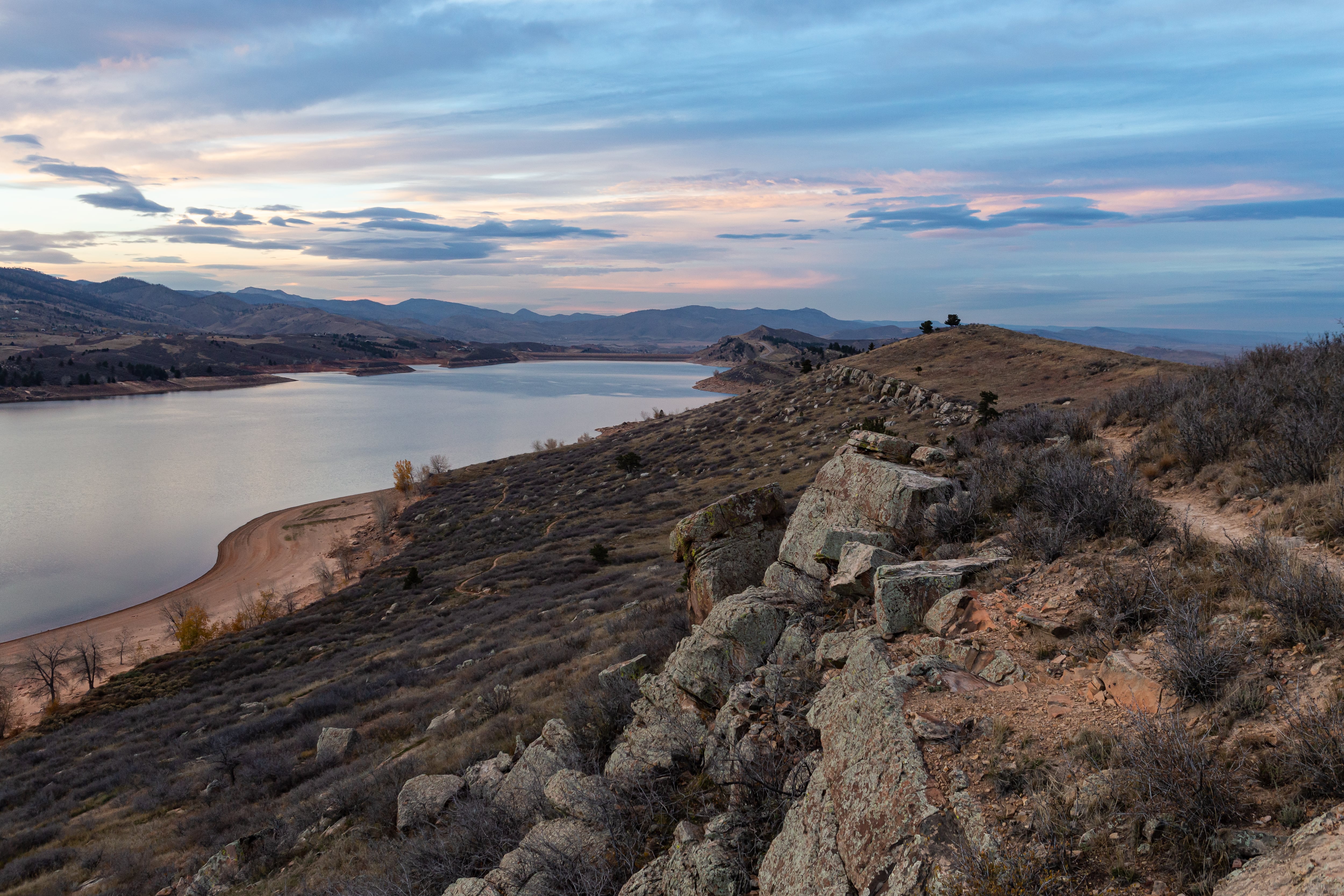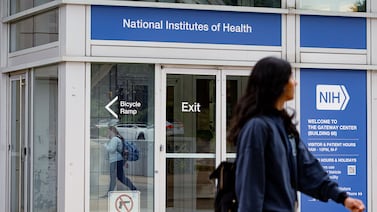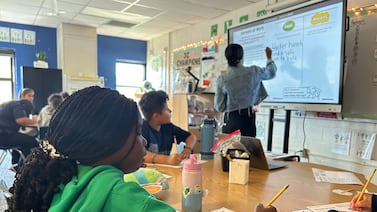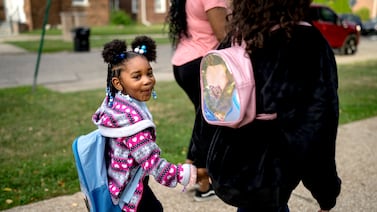Sign up for Chalkbeat Colorado’s free daily newsletter to get the latest reporting from us, plus curated news from other Colorado outlets, delivered to your inbox.
Yajaira Fuentes-Tauber majored in biology at college and planned to go to medical school. But a stop-gap job teaching science in Texas changed the course of her career.
“I realized that while I liked medicine, I loved teaching,” she said.
Today, Fuentes-Tauber teaches biology at Rocky Mountain High School in Fort Collins, Colorado, and is passionate about increasing access to STEM education and empowering students to become change agents.
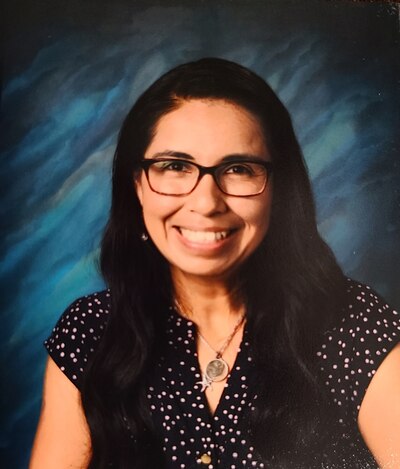
Her students have published books about river otters and created “bee hotels” out of reclaimed wood.
Fuentes-Tauber was named 2023 Earth Science Teacher of the Year by the Rocky Mountain Association of Geologists Foundation and was also one of three Colorado science teachers named state finalists in the 2022-23 Presidential Awards for Excellence in Mathematics and Science Teaching.
Fuentes-Tauber talked to Chalkbeat about her initial misconceptions about teaching, how her students are improving watershed health, and what she does to make ocean health relevant to students in a land-locked state.
This interview has been lightly edited for length and clarity.
Was there a moment when you decided to become a teacher?
I graduated from college early and needed something to do while my husband, who had served in the Coast Guard, finished his bachelor’s degree.
My first job was at Rivera High School in Brownsville, Texas, an area with high levels of poverty and teacher shortages. With a week before students were back in the classroom, the principal had to take a leap of faith in offering me a full-time science teaching position, which included a concurrent alternative teaching certification program.
I planned to pursue a medical degree, but after teaching for one semester, I decided to change careers and pursue a master’s degree in science education and then a doctorate of education.
How did your own experience in school influence your approach to teaching?
As a Hispanic, Latina, English learner, and first in my family to graduate from high school, I didn’t truly experience representation in the classroom. Many teachers didn’t look like me or have the same socioeconomic status or immigration background as I did. A number of teachers in our district were part of Teach for America and they were not representative of our school ethnic groups, nor did they speak Spanish.
The factors that shape my identity have been key in bringing a different perspective to my own teaching practices. I am passionate about advancing access to STEM education because I believe that through equity, diversity, and inclusion, students can pursue their interests regardless of their identity. Much like our school motto I believe that the strength of the pack is the wolf, and the strength of the wolf is the pack.
Tell us about a favorite lesson to teach. Where did the idea come from?
One of my favorite lessons is where students explore the impact of environmental changes through the lens of ocean acidification.
Students use different color beads to represent chemicals involved in the process that causes oceans to become acidic. The activity incorporates the chemistry behind ocean acidification to help students see how this process reduces the chemical compound needed to form shells and skeletons.
Ocean acidification and sea levels is something that I had background on, having taught for eight out of 17 years in South Texas, but to my current students exploring these topics when they live in a landlocked state felt irrelevant. I wanted to raise awareness about the interconnectedness of our ecosystems. As future leaders, they need to understand how our actions impact others miles away and how changes occurring miles away have the potential to impact our community.
With the loss of coral reefs, which provide coastal protection during storms, ecotourism, and habitat for diverse species, people may migrate to inland communities. This can impact the housing market, jobs, greenhouse emissions, and the transmission rates of communicable diseases. As future voters, they are most struck by considering how a shift in population could impact the electoral college, as the number of votes is dependent on a state’s population.
What is the Caring for Our Watershed contest?
Caring for Our Watershed is an international program that empowers students to take action to improve the health of their local watershed. One of the regional contests takes place in Northern Colorado, where a panel of judges selects proposals for funding by organization’s sponsors
Our students focus on The Big Thompson and the Cache la Poudre River Watershed in developing their proposals. Most recently, we had a team that wrote and illustrated a book about river otters that was printed and read at local elementary schools.
Another project selected for funding included a student making “bee hotels” using reclaimed wood to increase habitats for bees as they are crucial in maintaining a healthy watershed.
I love that this program allows students to become agents of change while still in high school. Over seven years, students have received over $13,000 in awards and we’ve received matching funds.
Tell us about a memorable time — good or bad — when contact with a student’s family changed your perspective or approach.
It has been bittersweet to learn about issues impacting students and their families in ways that are not visible or even recorded by schools. On the one hand, it is amazing that they see me as a trusted adult, and on the other hand, I’m struck by the weight of their burdens.
Learning about issues such as immigration status and languages spoken at home has prompted me to take a more inclusive approach to teaching. I integrate opportunities for “windows and mirrors” to ensure that I create a supportive environment where all students feel valued.
For example, when students explore the expansion of businesses in undeveloped areas with native species, they take into consideration the many perspectives that stakeholders bring to the table. Some may see themselves in the “mirror” if they have family members who work in construction, while providing a “window” for students who do not share the same perspective.
What was the biggest misconception that you initially brought to teaching?
When I intended to go to medical school, teaching was initially seen as a brief detour to fill a time gap in my plans. In our community, becoming a teacher was often perceived as an easy career path, in which you have an 8-hour-a-day job with paid holidays and paid summers off.
Once in the classroom, I quickly realized that teaching is far from an easy task and our commitment goes beyond contract times, not to mention summers are not really paid time off. Yet despite this initial misconception, I loved the challenge. I loved being part of the students’ journey to self-discovery and educational empowerment. My immediate family has always valued education and they were supportive.
What are you reading for enjoyment?
The last book I read for a parent book club was “The Bright Side of Going Dark” by Kelly Harms, and I’m waiting to get the next book for our club: “The Survivor’s Guide to Family Happiness” by Maddie Dawson. I’m also waiting for “Understanding Imperiled Earth” by Todd J. Braje.
Ann Schimke is a senior reporter at Chalkbeat, covering early childhood issues and early literacy. Contact Ann at aschimke@chalkbeat.org.

